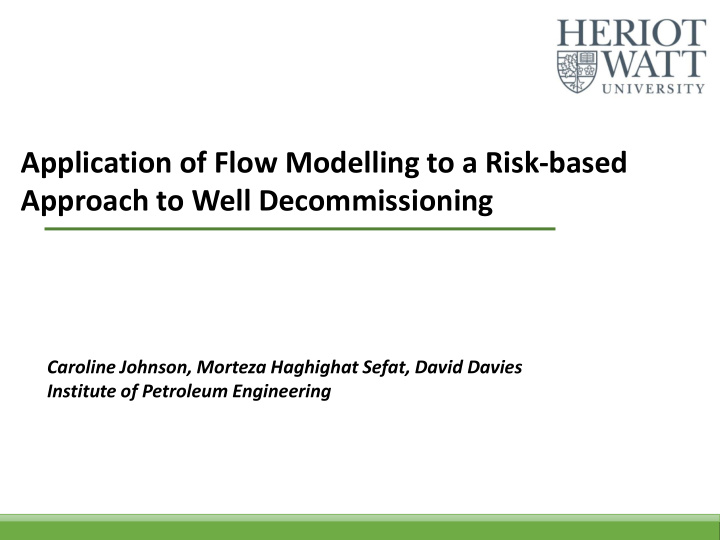



Application of Flow Modelling to a Risk-based Approach to Well Decommissioning Caroline Johnson, Morteza Haghighat Sefat, David Davies Institute of Petroleum Engineering
Risk-based approach to Well P&A Design • UK well P&A expenditure forecast over the next decade: £ 7.5 billion* • Urgent business need for a risk-based approach → fit for purpose, well specific design. • P&A system long-term performance modelling required to assess risk and support cost- saving decision making process P&A System Model Probabilistic Analysis ✓ Probabilistic evaluation of proposed P&A scenarios *2018 Decommissioning Insight, Oil & Gas UK 2
Possible Modelling Techniques 𝑙𝐵 annulus 𝑅 = ∆𝑄 − 𝜍𝑀 cos 𝜄 tubing 𝜈𝑀 valves wellbore Chokes = restrictions (e.g. cement plug) 3 *Moeinikia, F., Ford, E. P., Lohne, H. P., Arild, O., Mansouri Majoumerd, M. & Fjelde, K. K. 2018. Leakage Calculator for Plugged-and-Abandoned Wells. SPE Production & Operations .
Developed Grid-Based Framework – Sample Application Gas Saturation P&A Schematic Using: • In-house pre/post processor 26” Hole, • Commercial simulator as back-end engine. 20” Casing Scenario: • Open hole completion • Reservoir: Gas, Constant P = 5000 psia 17” Hole, • Wellbore: Water-saturated, intact cement k= 1 μ D 13 3/8” Casing P&A Model Outputs Animation Flowrates 12 ¼” Hole, 9 5/8” Casing 8 ½” Hole Cement • Results consistent with expected trends Inactive cells • Validation of absolute flowrates using Casing Cap Rock physical experiments would be ideal Formation 4
Key parameter: effective permeability ( k eff ) Effective Permeability Multiphase flow in porous medium k eff = k . k r (k = absolute permeability, k r = relative permeability) 1 plug Model Sensitivity Study: Simulated Flow Rates Absolute k (with its associated Cement with varying degrees of isolation modelled with range of k supported by literature uncertainties) is a more important parameter than k r . ✓ Model application: identify most important input parameters 5
Conclusions • Numerical grid-based finite difference modelling works! • The key input: k eff of cement, driven primarily by the absolute k . • To improve reliability (especially for probabilistic analysis ) • more data and a deeper understanding of flow properties of cement with different degrees of isolation required. • All P&A scenarios can be modelled using our developed framework , • including through-tubing P&A, which is of particular interest from a cost-saving perspective. Cement Plug /Sheath More data required for reliable probabilistic analysis 6
Acknowledgements This work is sponsored by the Oil and Gas Technology Centre and supported by the following North Sea operators. Software license provided by Email: Dr. Morteza Haghighat Sefat (m.h.sefat@hw.ac.uk) 7
Recommend
More recommend